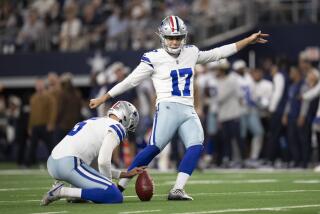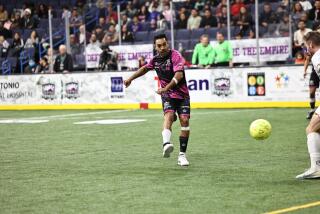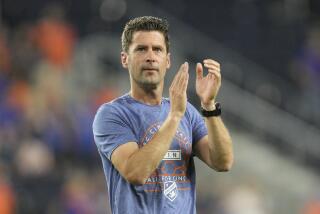SOCKERS’ NO. 1 GOALIE IS GORSEK AND TOTH : Twice as Nice
SAN DIEGO — As the Sockers’ goalkeeper, Zoltan Toth and Jim Gorsek are No. 1. Not No. 1 and No. 2. Simply No. 1.
“Whoever is playing that day is No. 1,” Coach Ron Newman said.
That is the way it seems to be going these days. Indoor soccer teams are opting for more than one goalkeeper, not as a starter and backup but rather two “starter-quality” goalkeepers.
Playing a 48-game regular season schedule has created this need. What was once considered a luxury has become a necessity.
The Kansas City Comets have Manny Schwartz and former Socker Alan Mayer. Baltimore has Keith Van Eron and Scott Manning. Former Cosmo Hubert Birkenmeier has been brought in to share duties with Victor Nogueira in Chicago.
In the Sockers’ case, Toth and Gorsek alternate games. Both welcome the platoon system.
“It’s easier having two goalkeepers on a team because it gives us time to recuperate from injuries and it puts a lot less pressure on us,” Gorsek said.
Toth would prefer not to play back-to-back games and feels being platooned could add years to his career.
“Playing goalkeeper is very tough,” Toth said. “It’s not like hockey where you wear a lot of protection.”
He should know. Toth missed nine games with a broken ring finger on his right hand early last season. Gorsek had a pinched nerve in his neck that forced him to miss the first six games last year.
In addition to alternating Toth and Gorsek, Newman has replaced one for the other in certain situations.
“When we started this last season,” Newman said, “we had no problem with them being alternated. But I had to sit down and tell them I wanted to also have the opportunity to take one out and put the other in.
“When you get the first shot past a goalkeeper, it is a major achievement for the other team. The barrier is broken. Sometimes the goalkeeper just doesn’t have it that day. Switching them is available as a tactical weapon.”
On occasion, Newman will switch them to enable the Sockers to match up better against an opponent. In the fourth game of the championship series against Baltimore last year, Toth faced more than 50 shots and gave up 10 goals in a 10-7 loss. Gorsek was in goal when the Sockers won the fifth game, 14-2.
When the teams returned to San Diego, Newman opted to start Gorsek again. The Sockers won, 5-3, to clinch the championship.
“Against Baltimore,” said Gorsek, “you can’t play a wide-open game. When there is confusion, that’s when things start going bad. I slow things down against a team that tries to play a wide-open game. I do a great deal of talking and try to be in control all the time. I try to control the pace of the game.”
Zoltan Toth and Jim Gorsek really have only one thing in common--their job descriptions.
In terms of background, personality, life style and even taste in food, they are as different as the pitches thrown by Phil Niekro and Dwight Gooden.
When he was 8 years old, Toth was making diving saves and listening to his father tell stories about his glory years as a star goalkeeper in Hungary’s professional league.
Gorsek grew up listening to people tell him he was too small to play sports. He barely knew what soccer was until he was 17.
“Toth has a big pedigree for outdoor,” Newman said, “and Jim is a lumberjack who comes from nothing.”
Toth is flamboyant, both on and off the field. His father used to receive standing ovations for simple goal kicks, and he grew up wanting to be just like his dad.
Before the championship series last year, Baltimore Blast Coach Kenny Cooper said: “I’m afraid of Jim Gorsek because he does the basics very well. He makes everything look simple.”
There you have it. Gorsek is basic and workmanlike.
When he played for the New York Arrows, Toth ran in the fast lane and frequented discos. In 1983, he won the Major Indoor Soccer League’s 10 1/2 award as the league’s best-looking player.
Gorsek is a licensed carpenter who spends the off season working on his home in Oregon.
Toth enjoys what he calls “Hungarian gypsy food.” Gorsek’s favorite foods are hamburgers and potato chips.
These are the Sockers’ goalkeepers--hamburgers and nails for one and dash and discos for the other.
As a storyteller, Toth has to be among the league leaders. And he has some fascinating and eye-opening stories to tell.
“My father was my idol. I listened to his soccer stories and I wanted to be like him.”
George Toth played for Gamma from 1939 to 1952. Zoltan never saw him play in a game, but he practiced with him regularly, saw him work out and listened to lots of his soccer stories.
“People told me he had such a style,” Zoltan said. “They said that when he came out for a cross ball, he had to fly. He used to say ‘If I was as tall as you (Zoltan is 6-foot 3-inches), getting cross balls would be like cake.”’
Zoltan started as an outdoor goalkeeper and still considers that to be his first love.
The younger Toth played for Hungary’s national outdoor champion Ujpesti Dozsa Budapest from 1977-79 and for the Hungarian Olympic and national teams in 1980.
While on tour with the Olympic team in Cadiz on the Spanish Coast, Toth defected to the United States in 1981. A successful stint with the Arrows was followed by his signing with the Sockers as a free agent on May 22, 1984. His 18-3 record (4.21 goals-against average) was the best in the MISL last season.
“I’m really too tall for indoor,” Toth said. “Being big is good for cross balls in outdoor.”
One of the highlights of Toth’s indoor career was when his father came to see him play during the 1981-82 season.
“The game was new to him and the country was new to him,” Toth said. “He liked it and said there was lots of excitement. He was 67 at the time and had been around soccer his whole life, and now he was seeing something new in the game.”
“Fixing games happened all the time,” Toth said. “There would be 80,000 fans in the stands and you would have to play the game as someone told you. I played a quarter of a season where I was told to make mistakes. If you don’t play the way they tell you, you are out.”
Toth, whose father also had to fix games throughout his career, recalls one game that particularly sticks out in his mind.
Ujpesti Dozsa was playing its chief rival Ferencvaros in front on 90,000 fans. Before the game, Toth was told the game had to end in a 1-1 tie.
“I said, ‘What?,’ ” Toth said. “During the game the defense thought they would let guys go and it would be at least 1-1. I was making saves and the other team wasn’t scoring. We led 1-0 with 15 minutes to play. That’s when our captain came over to me and said I had to let in a goal.”
The game ended in a 1-1 tie.
“Once I had to hide away from the ball to let a penalty kick score to make it 2-2,” Toth said. “It was a joke. I felt I was cheating myself and the fans because we didn’t play fair games. This killed me.
“Hungary is done for me. I’m glad I don’t play over there.”
He is also glad he doesn’t live over there. He received his United States citizenship this summer and went back to visit his father for the first time since he left.
It was the final weeks of the 1983-84 season. The Arrows, with Toth in goal, were in Kansas City to face the Comets. Kansas City and the Arrows were both owned by David Shoenstadt. The Comets were fighting to gain a playoff spot and were playing in front of a sellout crowd in Kansas City.
“Before the game,” said Toth, “Joe Machnik (Arrow coach) had a meeting with Shoenstadt. After the meeting, he came into the locker room and spit against the wall. Everyone knew why the coach was so crazy.”
Toth said a fired-up Arrows team beat a more talented Comet team, 5-4. He added that shortly thereafter the Arrows beat the Comets again in New York.
Machnik was fired after the season.
Jim Gorsek is the type of employee any boss would love to have. “Hard work is not foreign to me,” Gorsek said. “They always said I was too small to play sports, but I’m an athletic person who is very competitive.”
He played a lot of sandlot football, baseball and basketball in Oregon City. At 5-11, he was able to dunk a basketball.
However, his only participation in organized sports was as a wrestler in seventh grade.
When he was 17, he suddenly starting playing soccer.
“After six months of playing,” Gorsek said, “I tried out for the Portland Timbers.”
Talk about nerve and determination.
Shortly after his tryout, Gorsek signed an amateur contract with the Timbers and was working out with a professional team.
“I worked my tail off,” Gorsek said. “I was playing soccer six and seven days a week. Day and night. For three years, soccer was an all-day job. That’s how I learned to play.”
He even loves to practice.
“I’ve always liked hard work,” Gorsek said. “I have to be in there in practice. That’s how I stay sharp.”
Gorsek is more intense in practice than many players are during in a game. He believes that a team plays the way it practices.
Sound familiar. Jim, have you thought of going into coaching? “I think it would be interesting to coach one day,” Gorsek said.
For now, he is a coach on the field. And a successful one. He was 19-8 during the regular season last year and was 7-1 with a 2.44 goals-against average in the playoffs. In the 1983-84 season, he led the North American Soccer League with a 14-4 record and 4.08 goal-against average.
Gorsek has always enjoyed being involved. Very involved. Much to the chagrin of some of his defenders, it’s not unusual to occasionally see Gorsek race up the field with the ball.
“The reason I enjoy indoor more than outdoor,” Gorsek said, “is because you are more involved. You have to be aware the whole 60 minutes in indoor.”
In a recent article in the Baltimore Sun, Blast Coach Kenny Cooper was asked about the relationship between goalkeepers Scott Manning and Keith Van Eron.
“Look, they rarely talk to each other or look at each other in the eye,” Cooper said. “I guess I’m the mediator. The only thing that matters is that they place everything else to the side and help the Baltimore Blast win.”
There is a much friendlier attitude among the goalkeepers in San Diego. “We have a competition that makes us better on the field,” Toth said. “We help each other out.”
Gorsek and Toth go through a vigorous warmup drill that is probably more fun for the shooter, but obviously more helpful for the goalkeeper.
The player not starting in goal begins by booting a few soft liners toward the goal. Warm up the hands. Then come the kicks from the right side, the left side, straightaway and in the corners. Play the angles. A few ricochets off the boards and the glass and it’s time to get serious.
“Then we really start blasting them at one another,” Gorsek said.
At that point, either the flamboyant one or the lumberjack is ready to go.
“I wouldn’t swap that pair for anyone else,” Newman said.







